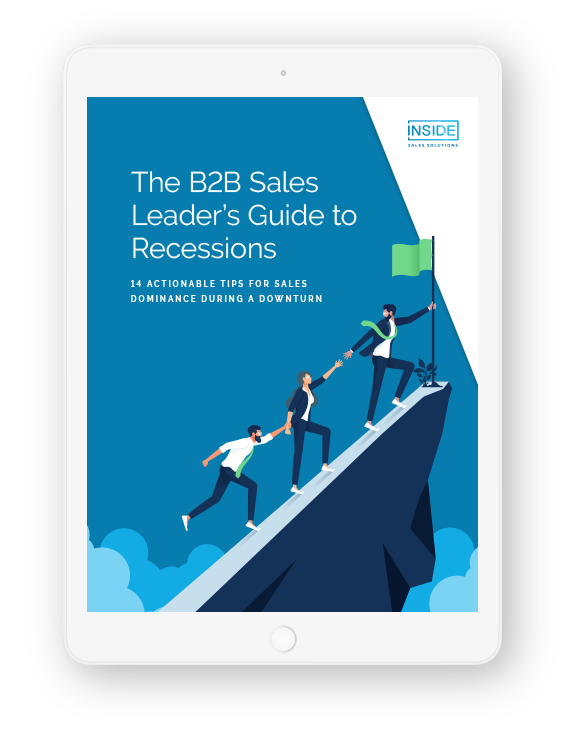And if you want to build a team of all-star sales professionals, investing the time and resources to get your sales training right is essential.
Ultimately, your inside sales training should be designed to help your organization drive revenue and maximize sales performance. But with today’s average sales rep tenure at just 14 months, there’s more to good training than just bottom line results.
Your inside sales onboarding needs to be detailed, structured, and based on clear expectations from the beginning. When your new hires immediately see the value in your mission and purpose, they’re far more likely to stick around…and crush their sales goals.
When considering how to train your sales team, use these 9 proven tips and best practices for creating a world-class inside sales training program.
Get the Ultimate Guide to Maximizing Channel Sales
1. Good training starts with good hiring.
If you start off by building a sales team that doesn’t align with your company’s core skill requirements and culture, your inside sales training will be for naught—no matter how good it is.
Getting the right people to fill your sales roles can be a challenge. In order to find the perfect mix of talent and experience, you must ask the right questions and look for the right qualities.
Bringing in those who are truly passionate about your product/service and mission is half the battle. When interviewing candidates who will eventually end up in your inside sales training, zero in on the ones who are genuine, self-motivated, and organized. With the right people, your sales training often takes care of itself.
2. Crawl. Walk. Run.
No doubt your sales process is specific. There are caveats and nuances with the way you must communicate with potential customers. Your sales tools and tech stacks are unique and customized. There’s a lot to consider and account for when selling your distinct brand and vision. But all those finer details come with time.
When you begin your sales development, make sure your topics are easy to understand. It’s always best to start with the basics, like:
- Articulating your value proposition
- Becoming an effective listener
- Using empathy
- How to be a problem solver
- Scripted responses to common objections
- The basics of cold calling/emailing
- Identifying bad customers
- How to open and close a sale
After you you’ve trained your sales team on how your organization handles the basics of “blocking and tackling,” it becomes much easier to delve into the depth and breadth of your service offerings.
3. Expose your new hires to multiple voices within the company.
Depending on the size of your company, you might have several departments with dozens, or even hundreds, of employees. Sure, the sales team is on the frontlines pounding the pavement, but there are multiple perspectives within your organization.
Marketing can tell you all about pain points and value props.
Customer support can tell you how the end user interacts with your product or service.
Product development can tell you everything that goes into producing what you’re selling.
HR can tell you about company culture.
Upper management can dive deep into the values and long-term vision of the company.
You get the point. It’s never good to work in silos, and the more companywide viewpoints you share during the inside sales training process, the more insightful and prepared your team becomes.
4. Then introduce them to others actively in the role.
While it’s important to expose your new hires to key players from all departments during the training process, they should become even closer with their fellow sales reps. Not only does this help develop camaraderie and promote collaboration, but it provides invaluable real-life insights that go far beyond standard training.
All salespeople have their own idiosyncrasies. Tips, tricks, techniques, and best practices they’ve picked up and perfected through the years.
The most successful inside sales training programs know that sharing is caring—one team, one dream. With those mottos, individuals flourish, teams prosper, and the company sees bottom line results.
5. Keep your training structured.
The best inside sales trainings schedule the core skill development modules based on priority and stick to the schedule. Too often, companies have a great plan but don’t stick to the schedule and end up leaving a lot of transferable knowledge on the table.
Focus on what matters most in the early days of your inside sales training. That’s when information retention is at its highest point.
Whether your courses are structured in-person or online, take on more of a workshop format, bring in outside consultants, or use a combination of strategies—keeping things structured, easy-to-follow, and sequential is critical to retention, and ultimately, success.
6. Dial in early.
The prospect actually answered my call…they picked up the phone! Now what…
Fearing the phone is common for any new inside sales rep.

Getting your new hires familiar with the phones early will lessen the curve and build their confidence in making calls.
Create sales call scripts, do some role playing, and go over tactics and rebuttals for handling objections and rejections. Be sure your inside phone sales training stresses the importance of active listening and building rapport on a call.
7. Share the good, bad, and the ugly.
We’re all familiar with bad sales techniques. They focus on products instead of people. They lack empathy. They talk too much. They think everyone’s a prospect…
The list goes on, and no doubt you have some real-world examples you can share during your sales training. Just as important as showing your new hires how to sell is showing them how not to sell. This will help eliminate misaligned expectations.
8. Be supportive.
Starting any new job can be daunting, and it’s easy to get overwhelmed in a hurry. Getting off to a bad start can be disastrous.
According to the Wynhurst Group, 4 percent of new employees leave a job after a disastrous first day, and most decide whether they feel “at home” in the first three weeks at a new job. Even more telling? 22 percent of staff turnover occurs within the first 45 days of employment.

You can squash any doubts your new hires might have from the outset—during your inside sales training— by simply reminding them that they have a full support system behind them for any of their needs and all of their questions.
Mistakes happens and it’s important that they know where to go and who to ask if they have any questions as they get started.
9. Have fun.
Perhaps most important of all when training your new sales hires—have fun!
“1 out of 3 employees say uninspiring training content is a barrier to their learning.”
Source: Train Like a Champion Infographic.
One out of every three employees say boring training content stifles their learning. Whatever you do, make sure your inside sales training program informs and entertains. Not only will the training be more enjoyable for everyone, but the information will be absorbed at a much higher rate.
Looking to Expedite Your Inside Sales Training?
Perfecting your training program is necessary for success, however many sales teams don’t have the time and resources it takes to fully develop their inside sales training.
For some, outsourcing their sales makes sense because it provides a team of experts already trained and ready to hit the ground running in a fraction of the ramp-up time.
Considering Outsourced Sales Development?
Take a peak at how B2B sales teams can overcome economic uncertainty.


